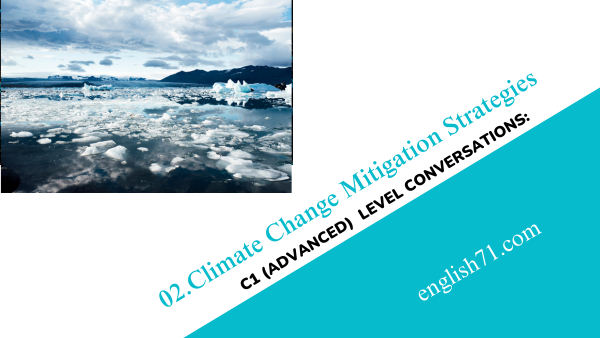C1 (Advanced) level Conversations: (2) Climate Change Mitigation Strategies

Tom: Hi Marie, have you been keeping up with the latest strategies for mitigating climate change?
Marie: Hey Tom, absolutely! It’s such a pressing issue that requires collective action. What specific strategies have caught your attention?
Tom: Well, I’ve been reading about the importance of transitioning to renewable energy sources like solar and wind power. It seems like a crucial step in reducing carbon emissions.
Marie: Absolutely, transitioning to clean energy is key. I’ve also been intrigued by discussions around energy efficiency improvements in buildings and industries. It’s amazing how much energy we can save through simple measures.
Tom: Definitely, energy efficiency is low-hanging fruit in the fight against climate change. Another area I find interesting is reforestation and afforestation efforts to absorb carbon dioxide from the atmosphere.
Marie: Yes, restoring and conserving forests play a vital role in carbon sequestration. And speaking of carbon, have you looked into carbon pricing mechanisms as a way to incentivize emission reductions?
Tom: I have. Carbon pricing, whether through taxes or cap-and-trade systems, can provide economic incentives for businesses to reduce their carbon footprint. It’s a market-based approach that seems promising.
Marie: Absolutely, and it’s encouraging to see more countries and regions implementing carbon pricing policies. I’ve also been following discussions on sustainable agriculture practices as a means of reducing emissions.
Tom: Sustainable agriculture is crucial for food security and environmental sustainability. Practices like crop rotation, organic farming, and precision agriculture can help reduce emissions from the agricultural sector.
Marie: Agreed. And let’s not forget about the importance of transitioning to electric vehicles and improving public transportation infrastructure to reduce emissions from the transportation sector.
Tom: Definitely. Electrifying transportation and investing in green infrastructure are essential steps toward decarbonizing our society. It’s inspiring to see so many innovative strategies emerging.
Marie: Absolutely, Tom. The challenge of climate change requires a multifaceted approach, and it’s heartening to see progress being made across various fronts. Let’s continue to stay informed and advocate for climate action.
Tom: Couldn’t agree more, Marie. By working together and implementing these mitigation strategies, we can create a more sustainable and resilient future for generations to come.
Marie: Well said, Tom. Thanks for this enlightening conversation. It’s always motivating to discuss solutions to such a critical issue with you.
Tom: Likewise, Marie. Let’s keep pushing for positive change and doing our part to address climate change. Our actions today will shape the world of tomorrow.



Summary:
Tom and Marie engage in a comprehensive discussion about climate change mitigation strategies. They cover various approaches, including transitioning to renewable energy, improving energy efficiency, reforestation, carbon pricing, sustainable agriculture, and electrifying transportation. Both agree on the importance of collective action and staying informed to address the pressing issue of climate change. Their dialogue highlights the multifaceted nature of climate mitigation efforts and the need for collaboration across sectors to create a more sustainable future.

